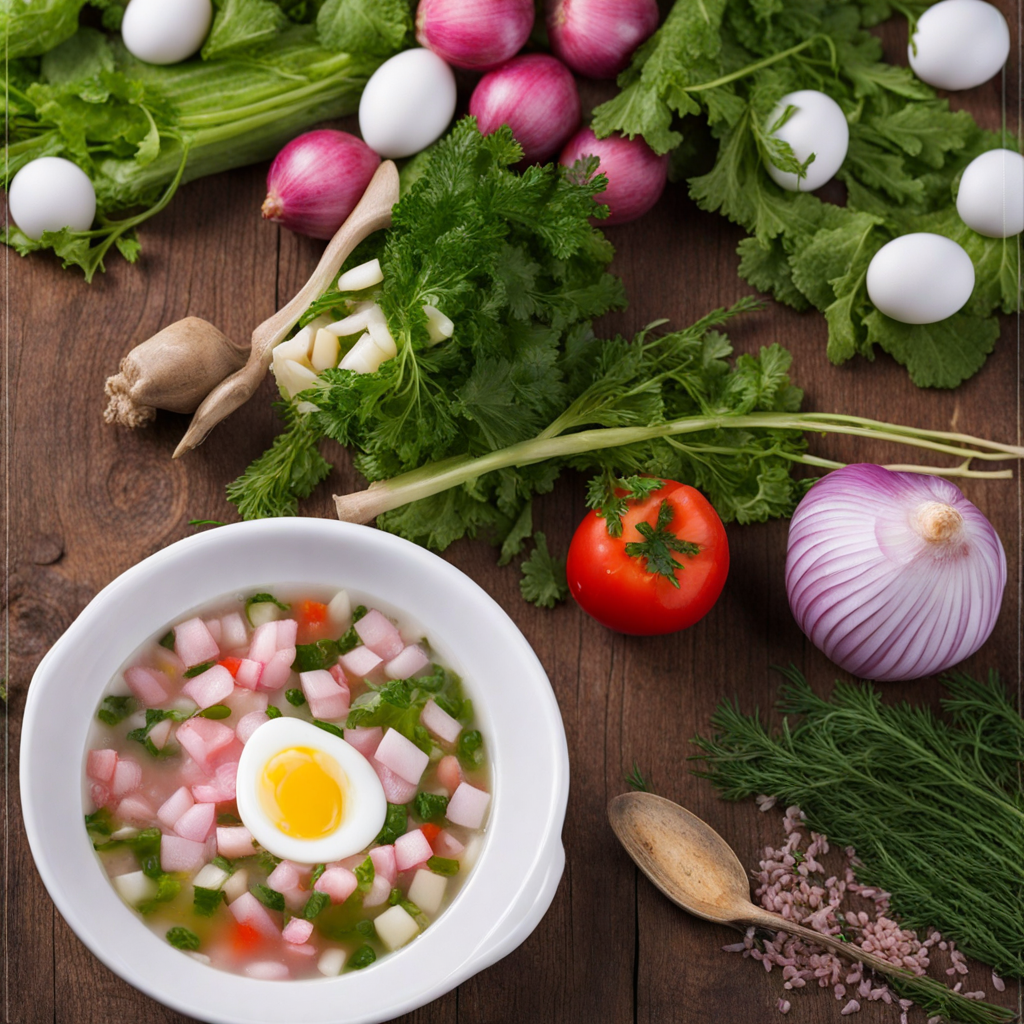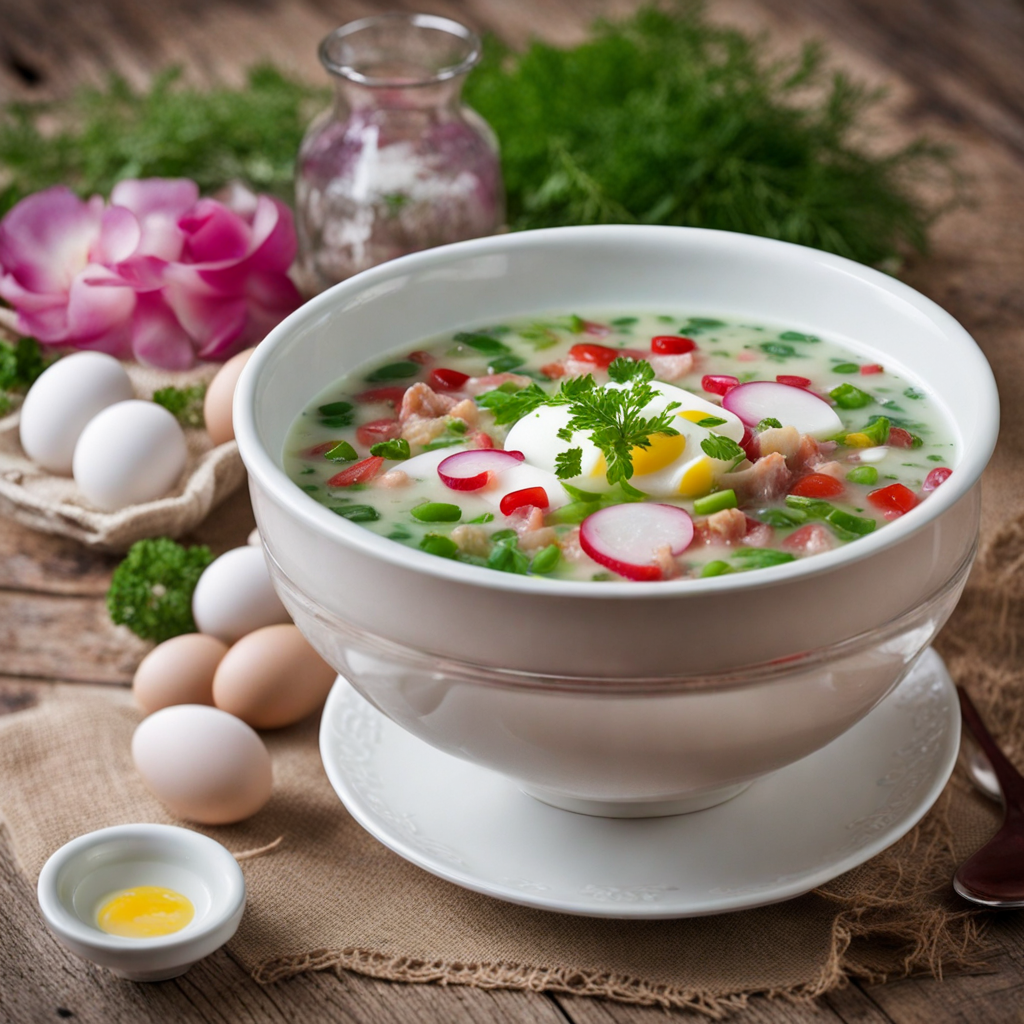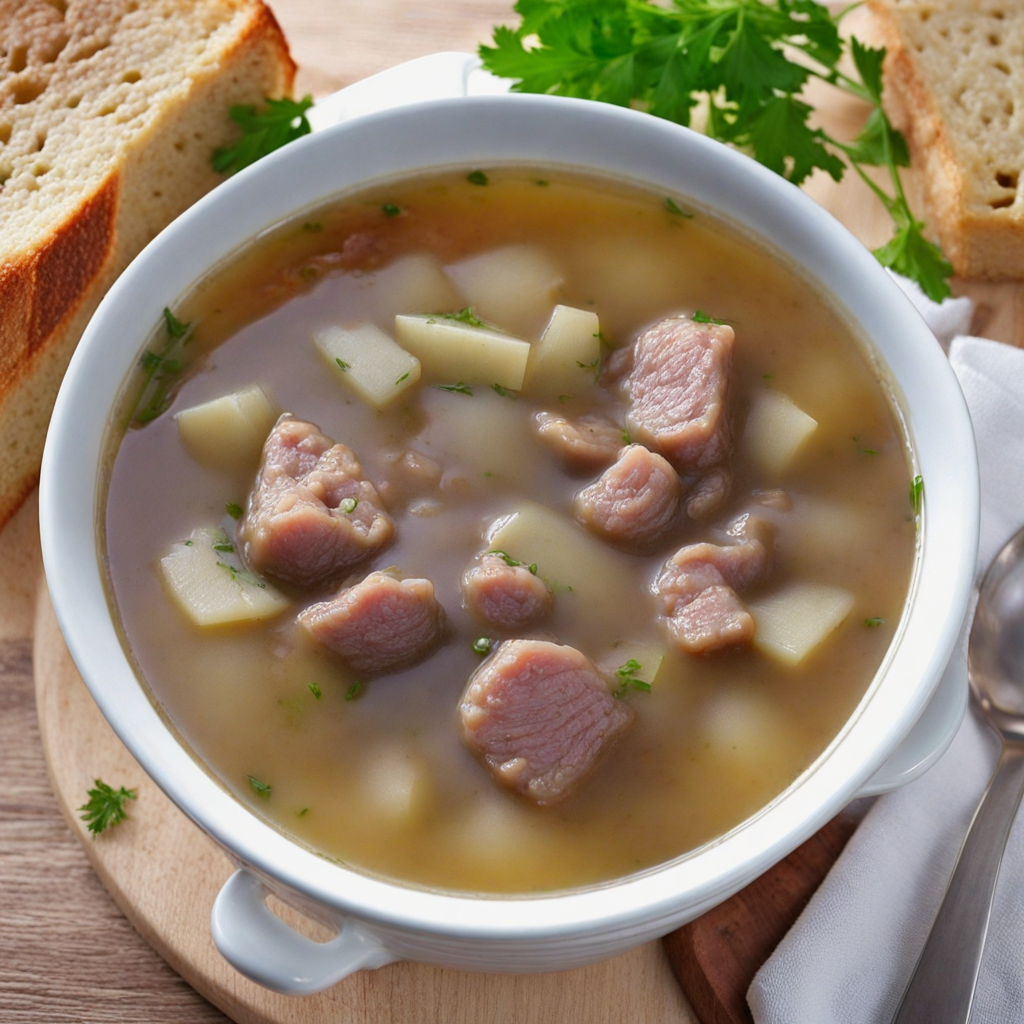Okroshka
Okroshka is a traditional Russian cold soup that offers a refreshing and unique taste experience, especially during the warm summer months. This dish is typically made with a base of kvass, a fermented beverage made from rye bread, which gives it a slightly tangy flavor. For those who prefer a lighter version, kefir or buttermilk can be used as an alternative base. The combination of kvass or kefir with finely diced vegetables creates a satisfying texture and a delightful balance of flavors that is both invigorating and nourishing. The primary ingredients of okroshka include a medley of fresh vegetables such as cucumbers, radishes, and boiled potatoes, combined with proteins like diced boiled eggs, sausage, or ham. These elements contribute to the dish's vibrant colors and diverse textures, making it visually appealing as well. Fresh herbs, such as dill and green onions, are often added to enhance the flavor profile, providing a fragrant and aromatic touch that complements the dish wonderfully. Each spoonful reveals a delightful crunch from the vegetables and a creamy, tangy backdrop from the kvass or kefir. Okroshka is typically served chilled, making it a perfect dish for hot days. It can be garnished with a dollop of sour cream or a sprinkle of additional herbs for added richness and flavor. This delightful soup not only embodies the essence of Russian summer cuisine but also offers a delicious way to enjoy seasonal produce. With its refreshing taste and hearty ingredients, okroshka is an excellent choice for food enthusiasts looking to explore new flavors and culinary traditions.
How It Became This Dish
The History of Окрошка: A Refreshing Taste of Russian Tradition Origins and Ingredients Окрошка (okroshka) is a traditional Russian cold soup that embodies the spirit of summer cuisine, combining fresh vegetables, boiled potatoes, eggs, and often meat or fish, all immersed in a light, tangy base usually made from kvass or kefir. The name "окрошка" derives from the Russian verb "крошить," meaning "to crumble" or "to chop," which aptly describes the dish’s preparation method. The origins of окрошка can be traced back to the 15th century, with its earliest mentions appearing in Russian literature during the era of Ivan the Terrible. It was initially a peasant food, utilizing the bountiful summer harvest and reflecting the agrarian lifestyle of the time. The use of kvass, a fermented beverage made from rye bread, lent a unique flavor profile and preservation qualities, making it an ideal base for a refreshing dish that could be enjoyed in the heat of summer. Cultural Significance Окрошка holds a special place in Russian culinary tradition, often associated with communal gatherings and summertime feasts. It reflects the Russian ethos of using seasonal ingredients to create vibrant and nourishing dishes that not only satisfy hunger but also celebrate the richness of the land. The soup is commonly served during festive occasions, family picnics, and outdoor gatherings, symbolizing hospitality and the joy of sharing. In addition to its social significance, окрошка also embodies the Russian approach to health and nutrition. The emphasis on fresh vegetables and fermented dairy products aligns with traditional beliefs about the benefits of consuming seasonal and locally sourced foods. The dish has been adopted and adapted throughout various regions of Russia, each contributing its unique local ingredients and variations, further enhancing its cultural tapestry. Regional Variations and Adaptations The beauty of окрошка lies in its versatility. While the classic version features kvass, many modern interpretations use kefir, a fermented milk drink, particularly in urban areas where dairy is more readily available. This shift highlights the adaptation of traditional recipes to suit contemporary tastes and the evolving culinary landscape. Different regions of Russia have their distinct takes on окрошка. In the colder northern parts, where kvass is less prevalent, some variations may use broth or sour cream, creating a richer, creamier texture. In the southern regions, where fresh herbs and vegetables are plentiful, the soup may be loaded with an abundance of greens, such as dill, parsley, and scallions, enhancing its aromatic profile. Furthermore, окрошка has transcended its traditional roots, making its way into modern Russian cuisine as a popular dish served in restaurants and cafes. Chefs now experiment with ingredients, incorporating elements from other culinary traditions, such as Asian influences or the incorporation of exotic vegetables. This evolution is a testament to the dish's adaptability and enduring popularity. Historical Context and Evolution During the Soviet era, окрошка gained prominence as a staple of the summer menu, reflecting the regime's emphasis on self-sufficiency and the promotion of traditional Russian foods. The introduction of centralized food production systems and agricultural collectivization influenced how ingredients were sourced and prepared. Despite the challenges of food scarcity, окрошка remained a beloved dish, celebrated for its affordability and ease of preparation. In contemporary Russia, окрошка has experienced a resurgence, often featured in modern cafes and restaurants seeking to revive traditional flavors with a contemporary twist. The dish has also gained popularity among health-conscious consumers, who appreciate its refreshing qualities and nutrient-dense ingredients. The rise of the farm-to-table movement has further supported the use of fresh, local produce, allowing chefs to experiment with seasonal variations and innovative presentations. Okroshka in Modern Context As globalization continues to influence culinary practices, окрошка has found its way beyond the borders of Russia. It has become a symbol of Russian cuisine in international food festivals and culinary competitions. Its refreshing qualities make it a suitable dish for warm-weather menus around the world, and its adaptability has allowed it to be embraced by various cultures. In recent years, many food enthusiasts and home cooks have taken to social media to share their окрошка creations, sparking a renewed interest in this traditional dish. Online platforms have allowed for the exchange of recipes and variations, showcasing the dish's regional diversity and inspiring new interpretations. This digital renaissance has not only preserved the cultural significance of окрошка but also encouraged a new generation to explore the flavors and traditions of Russian cuisine. Conclusion Окрошка is more than just a cold soup; it is a culinary representation of Russian culture, history, and community spirit. From its humble origins as a peasant dish to its contemporary status as a celebrated staple of Russian cuisine, окрошка showcases the resilience and adaptability of traditional foods. As it continues to evolve and inspire, this dish serves as a reminder of the importance of celebrating seasonal ingredients, communal dining, and the rich tapestry of flavors that define Russian culinary heritage. Whether enjoyed in a cozy dacha or a bustling city cafe, окрошка remains a refreshing testament to the enduring connection between food, culture, and community, a dish that not only nourishes the body but also warms the heart. As new generations discover and reinterpret this ancient soup, окрошка will undoubtedly remain a cherished part of Russia’s culinary legacy for years to come.
You may like
Discover local flavors from Russia







